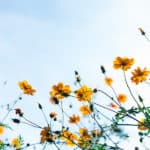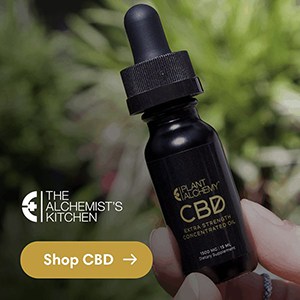What is that excited urgency we feel in the fall? It comes with magic and mystery, like a trickle down the spine or a prickle of hair on the back of the neck. We start to experience that inexplicable feeling that something lies just below the surface when foraging in the woods.
I believe it’s because this is the one time of year when we are closest to our ancestors. Through them, we can catch a glimpse of the thousands of-year-old weaving of life—the great mystery itself.
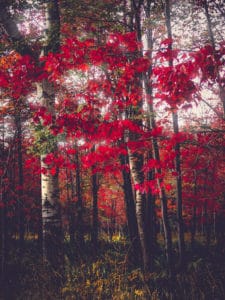
One of the best ways to strengthen these sacred connections is to forage the edges of the woods. Trees send shimmers of fire to all ends of the temperate world while fields rustle with drying leaves. This special place between the darkness of the woods and the light of the field represents the transition of summer into the winter. Fall is the edge, and within it lies an abundance of medicine to help us prepare for the dark half of the year.
Here, I’ll share some of my favorite fall edge plants with Wildcraft.
Sweet Fern (Comptonia peregrina)
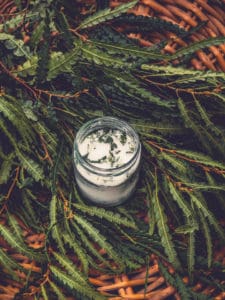
More than likely, you will smell this sage being before you see it. Its cinnamon-like scent wafts through dry, acidic forests. It ranges almost everywhere east of the Mississippi River and north into Canada. Despite its name, this fern lookalike is actually a shrub in the wax myrtle (Myricaceae) family. It shares the same woody aromatic characteristics as its other family members such as bayberry and sweetgale.
You’ll find sweet ferns at the edge of oak-dominated woods. They often grow in pure sand where few other plants can thrive. These stressful growing conditions help to enhance their powerful essential oil content. Note its woody stem, deeply lobed leaves, spreading branches, and 2-4 foot height. They typically grow in dense colonies.
Although it has obvious aromatics, sweet fern has been somewhat forgotten in modern herbal medicine. The indigenous people of North America borrowed its gifts to use as a smudge, treat diarrhea, and alleviate skin conditions. Those herbalists that currently use sweet fern in their apothecary have noted its impressive effects as a wash against poison ivy. They even dare to claim it is more powerful for this use than jewelweed, which has long been the go-to herb for such cases.
Harvest and dry the leaves of sweet fern by hanging them in bundles. They don’t have much water content, considering their growing conditions, so they dry quite quickly and can easily be ground into material for teas and washes.
New England Aster (Symphyotrichum novae-angliae)
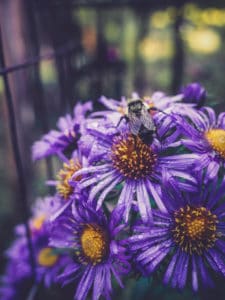
This showy purple lady of the edge was one of the first plants that captured my heart when I moved to the woods. Not many wild native plants demand your attention with such an intense profusion of color. They also capture the attention of our pollinators and provide some of the last sources of nectar they will collect before winter.
New England aster has nestled its way into the edges of our woodlands in almost every state, save a few Western and Southern states. It is most impressive when you find them growing in a spectacular blanket of purple and yellow with their favorite companion, goldenrod. These two don’t always grow next to each other, but they tend to thrive in more significant numbers when together. They grow in moist soils with part shade. If given free reign, they can grow six feet tall, though they often are happy at three feet. The purple heads release an unexpected sticky aromatic scent when picked.
The resinous flower heads can be harvested and dried for tea or tincture, though leave some on the stalk for our bees and butterflies. New England aster is most commonly used as a warming expectorant to relieve coughs and expel phlegm. This makes it perfect for preparing the apothecary for the long winter ahead. Herbalist Jim McDonald has also used it as an herbal smoke and noted its ability to “clear the head”.
Juniper (Juniperus communis)
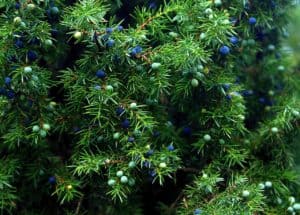
Defiant spires spring from the ground in all directions, refusing to lay docile against the windswept dunes. Its deep blue berries ripen to a deep indigo as the clock ticks toward autumn. Commonly overlooked as a “weedy” shrub, this prickly plant holds potent medicine if only we look.
Different types of juniper grow throughout the states, but only a few grow berries, and there are a couple that are poisonous. Most juniper berries contain low amounts of a compound called thujone (also found in common sage, mugwort, and wormwood), which is safe to consume. Still, a few species have higher amounts, making it potentially toxic. So be sure to identify which one grows in your area before harvesting. The common juniper listed here is both safe and medicinal. You’ll most likely find this spiky, low-growing shrub along the wood lines of dunes or lakes. They straddle the edge between the shelter and the strong winds across the water.
The branches can be used for smudging, and the berries are ideal for several digestive complaints. I use the berries in bitters blends to help expel gas and relieve indigestion. They are a warming medicine that can help revitalize the cold season. They also make a beautiful companion to sweet fern in a spice blend. The essential oil of juniper is coveted as a remedy for sore throats, respiratory infections, fatigue, muscle aches, and arthritis.
Check out our new Autumn Immunity herbal offering and discover plant medicines perfect for the coming cold!





